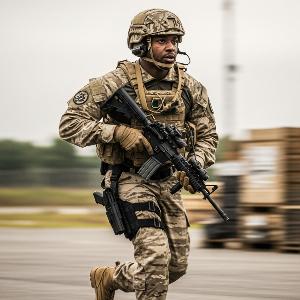In times of crisis, communication becomes paramount for survival and coordination among preppers. When traditional communication channels fail, having reliable and effective communication tools can make all the difference. This article will explore essential communication tools for preppers, ensuring that you stay connected in a crisis situation.
1. Marine Radios
For preppers who are near or on water bodies, marine radios are crucial for communication. Marine radios are designed for use on boats and watercraft. They operate on specific frequencies designated for marine communications and allow you to communicate with other vessels, marinas, and emergency services.
For a survivalist or someone engaged in maritime activities, various types of marine communications can be invaluable. These communication systems ensure safety, enable emergency assistance, provide weather updates, and facilitate general communication while at sea. Here are explanations of the usefulness of different types of marine communications:
-
VHF (Very High Frequency): VHF radios are commonly used for short-range communications within line-of-sight distances, typically up to 20 nautical miles. They are crucial for ship-to-ship and ship-to-shore communication, including contacting harbormasters, marinas, or other vessels in the vicinity. VHF radios are also used for distress calls and receiving weather updates from coastal stations.
-
HF (High Frequency): HF radios operate in the high-frequency range and have the capability to transmit over long distances, sometimes even intercontinental ranges. They are particularly useful when sailing in remote areas or crossing vast distances, as they can establish communication with other vessels, coastal stations, or even rescue coordination centers. HF radios require an operator's license and are often used for long-range voice communication.
-
SSB (Single Sideband): SSB radios are a type of HF radio commonly used by long-distance sailors or cruisers. They provide enhanced communication capabilities and increased range compared to traditional HF radios. SSB radios can be used for voice communication, email, and even accessing the internet via specialized services like SailMail or Winlink.
-
Weather Fax: Weather Fax is a method of receiving weather charts and forecasts via radio waves. It utilizes special receivers to decode and print weather maps, satellite images, and other meteorological data. Weather Fax is valuable for obtaining weather updates and forecasts while at sea, allowing sailors to plan their routes and make informed decisions.
-
Satellite Communications: Satellite communication systems offer global coverage and are highly useful for maritime communication. They can provide voice calls, data transmission, internet access, and even emergency distress signals. Satellite phones and satellite-based messaging devices, such as Iridium or Inmarsat, are commonly used by sailors and survivalists due to their wide coverage and reliability, especially in remote areas.
-
EPIRB (Emergency Position-Indicating Radio Beacon): EPIRBs are distress beacons that transmit emergency signals via satellite to search and rescue authorities. When activated, they provide the vessel's precise location, aiding in prompt rescue operations during emergency situations such as sinking, fire, or man overboard incidents.
-
AIS (Automatic Identification System): AIS is a system used for ship identification and collision avoidance. It broadcasts vessel information, such as position, course, and speed, to other vessels in the vicinity. While AIS primarily serves for safety and navigation purposes, it can also be beneficial for general communication and awareness of nearby vessels.
Each of these marine communication systems serves a specific purpose and can greatly enhance safety, emergency response, and overall communication capabilities for survivalists and maritime users. It's important to note that some systems may require licensing, while others may necessitate specialized equipment or subscriptions to satellite communication services.
2. Two-Way Radios
Two-way radios, also known as walkie-talkies, are invaluable communication devices for preppers. They allow direct and instant communication within a certain range without relying on cellular networks or the internet. Invest in high-quality, long-range two-way radios with multiple channels and privacy codes for secure communication.
3. Ham Radios
Amateur radio, or ham radio, is a powerful communication tool that operates on a range of frequencies and can reach far distances. To use ham radios, you'll need to obtain an amateur radio license, which requires passing an exam. Ham radios provide reliable long-range communication and can connect you with other ham radio operators, emergency services, and even international networks.
4. Satellite Phones
When all other communication networks fail, satellite phones can provide a lifeline. These devices use satellite technology to transmit calls and messages, allowing communication even in remote or disaster-stricken areas. Satellite phones are reliable, but they can be costly to purchase and maintain. However, for preppers who prioritize staying connected during extreme circumstances, they are worth considering.
5. Shortwave Radios
Shortwave radios, also known as world band radios, receive transmissions on various frequencies and can tune into international broadcasts. They can provide valuable information during crises and keep you updated on news, weather conditions, and emergency announcements. Invest in a high-quality shortwave radio that covers a broad frequency range and has advanced features such as Single-Sideband (SSB) mode for enhanced reception.
6. Portable Solar Chargers
Keeping your communication devices powered is essential in a crisis. Portable solar chargers harness the power of the sun to charge your electronic devices, including smartphones, radios, and other communication tools. Look for durable and efficient solar chargers that can withstand harsh conditions and provide sufficient power output to keep your devices running.
7. Signal Whistles and Mirrors
In situations where verbal communication may not be possible, signal whistles and mirrors can serve as effective tools for sending distress signals and attracting attention. Whistles with high decibel ratings can be heard over long distances, while mirrors can reflect sunlight to create visible flashes. These compact and lightweight tools should be a part of every prepper's communication kit.
8. Portable Hand Crank Radio
A portable hand crank radio is an excellent addition to your communication arsenal. These radios have built-in hand cranks that allow you to generate power by manually cranking a dynamo, eliminating the need for batteries or electricity. They typically feature AM/FM radio bands, weather alerts, and even built-in flashlights, ensuring you stay informed and connected in crisis situations.
9. Morse Code Guides and Reference Materials
Morse code, a method of communication using dots and dashes, can be a valuable skill to learn for preppers. Carry a Morse code guide or reference materials in your communication kit to communicate messages using sound or light signals. Morse code is a universally recognized language and can be useful for sending distress signals or relaying important information when other communication methods are unavailable.
10. Portable Wi-Fi Hotspots
In scenarios where cellular networks are still operational, having a portable Wi-Fi hotspot can provide internet access and facilitate communication. Portable hotspots use cellular data to create a local Wi-Fi network that you can connect your devices to. Ensure you have spare SIM cards and data plans stored in your emergency supplies to maintain internet connectivity when needed.
11. Offline Messaging Apps and Encryption Tools
Offline messaging apps and encryption tools can be essential for secure and private communication during a crisis. Look for messaging apps that allow offline messaging capabilities, enabling you to send and receive messages without an internet connection. Additionally, encryption tools can add an extra layer of security to your communications, protecting your messages from unauthorized access.
Conclusion
When traditional communication channels are compromised during a crisis, having reliable communication tools becomes vital for preppers. Two-way radios, ham radios, satellite phones, shortwave radios, portable solar chargers, signal whistles, mirrors, marine radios, Morse code guides, portable Wi-Fi hotspots, offline messaging apps, and encryption tools can greatly enhance your communication capabilities. By investing in these essential communication tools and incorporating them into your prepping strategy, you can ensure that you stay connected, informed, and coordinated in times of crisis.
Hashtags: #CommunicationTools #Preppers #CrisisCommunication #StayingConnected #EmergencyCommunication





